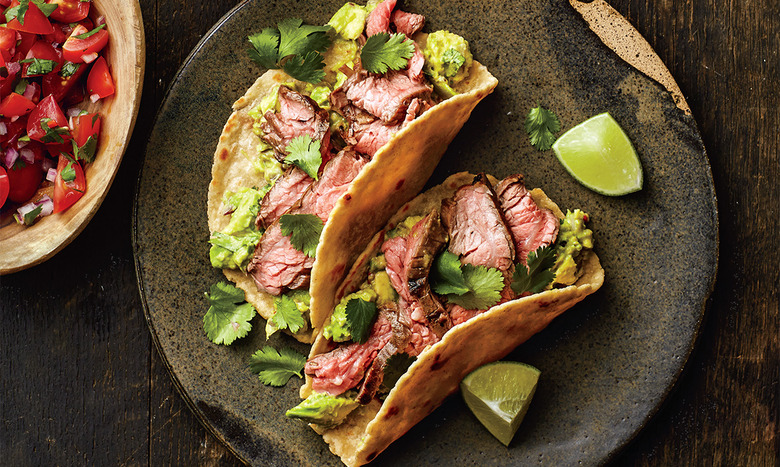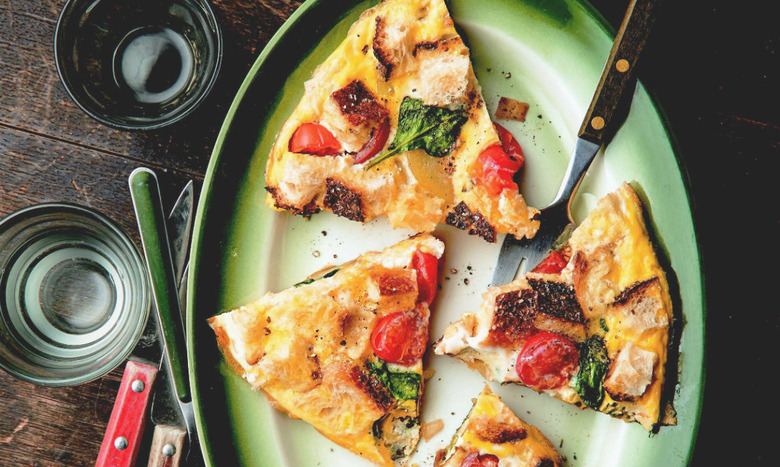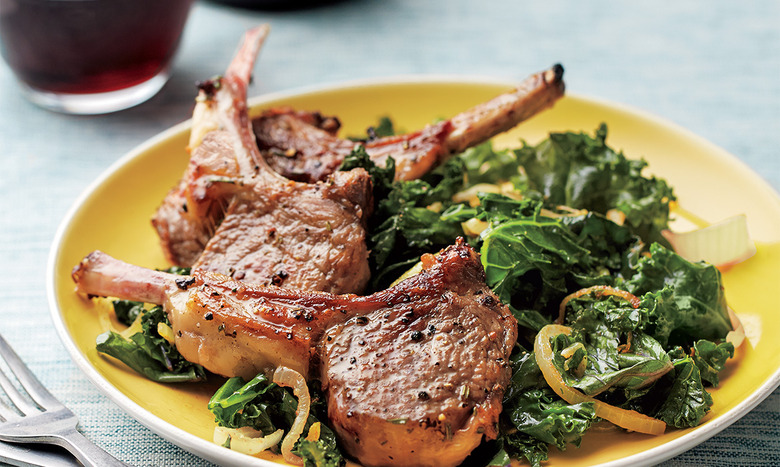Klancy Miller Shares How To Make Cooking For One Fun In 'Cooking Solo'
We may receive a commission on purchases made from links.
When we first stumbled upon Klancy Miller's new cookbook Cooking Solo, we thought, "How did no one think of this genre sooner? Why aren't there more cookbooks for singletons out there?" Recipes are usually portioned to feed a family, and cooking such large meals can take time, more time than most people want to spend on a meal for one.
As Miller points out throughout the book, cooking for yourself isn't just about saving money on take-out or expensive dinners in restaurants — it's about spending time with yourself. As most of us go-go-go all day long, taking that minute to slow down, breathe, and enjoy a moment of indulgence whether it be with friends or solo can actually be really hard. It requires you to flip a switch in your brain.
What Miller proposes here are not only delicious recipes that you can make with relative ease, either on your own or with friends and family, but also a reevaluation of (dare we say a self-help guide for) mealtime, and that a "family meal" doesn't always require a throng of kids at the table.
The recipes are largely influenced by her extensive travels and personal experiences with food, but they open the door for creativity in the kitchen with simple, delicious food anyone can identify.
We had the opportunity to talk more with Miller about her cookbook and what inspired her to focus on solo-cooking:
The Daily Meal: In general, what inspires you to cook?
Klancy Miller: It's kind of two-fold. I do love going to farmers markets. Seeing what's there is really inspiring in terms of if there is a really beautiful bed of spring greens or whatever the produce may be. I will kind of improvise off that. Another thing that inspires me is that I really love to travel. So, sometimes I am not necessarily trying to replicate exact dishes I had on a trip, but just little accents. Sometimes, going to restaurants inspires me too. It's, again, not necessarily about trying to make the exact same dish I had somewhere, but just reproducing something that was interesting in that dish. There is a salad that is kind of a take on that. There is a restaurant I love in New York called Il Buco [and] they have this great salad called cavolo nero, which is basically just kale with lemon and walnuts, but their dressing is a little bit more done up than mine, but I just kind of like the idea of combining lemon and walnuts in a salad — so little accents in different places.
What was the initial inspiration for this book?First of all, I always have cooked for myself and I never really took it that seriously. I started seriously cooking for myself when I was a culinary student in Paris. I was living on my own in a studio, and I quickly realized that if I was going to continue to go out to restaurants all the time, I would run out of money very quickly, so it was kind of a practical thing. So I have my own deep back pocket of recipes, and then I came across this article probably three years ago in the New York Times by sociologist Eric Klinenberg and he had just written a book talking about how there are more single people in this country than there ever have been, and that it is actually a pivotal moment in our country in terms of a big switch in demographics. I think there are over 31 million unmarried people in the states and I just thought wow, there are a lot of other people just like me in this country, and not just in the United States, but it's an apparently growing trend and we deserve our own cookbook. Even if you like to eat out all the time, sometimes you want a home cooked meal, and plus it also gets expensive. Regular cookbooks always serve four or six, and you end up with a lot of leftovers. I figured, why not come out with a cookbook where the servings are smaller?
In your opinion, what are the most important aspects and/or benefits of cooking for yourself?
I think it is two-fold. One thing is cooking for yourself is relaxing. It actually is a way for me to unwind. I think if you just let yourself get into the act, it is kind of cathartic. The other benefit is that you can also think of it as rehearsal. You are cooking for yourself and you don't have the added pressure of worrying about someone else's dietary restrictions. You can just cook whatever you want to cook. Also, by getting better at cooking for yourself, when you do have friends, loved ones, or a romantic interest, around your house, you can [cook] something for them — it makes you that much better of a cook.
I think it is really important for everyone to entertain in their homes. I think it's really nice to have people to share in your hospitality, and cooking for yourself makes you that much better at sharing in that fun experience with your friends.
What are some of the biggest challenges of cooking for one, and how does your book solve them?
One is I try to address the mental road block because a lot of people say, "Well it's just me, why do I want to cook for just myself?" So the first message I want to get across is you are worth it. A home-cooked meal, cooked by you is actually pretty simple.
Another way is that all of the recipes are pretty simple. I tried to make as many recipes as possible with [less than] 10 ingredients. They don't take that long to prepare, and most of the ingredients are pretty easy to find. I also tried to make them simple, so that you aren't wasting too much. I don't like food waste, and the idea is to buy quantities that you need for the recipes. Then, I also suggest ways that you can use the recipe in different ways. For instance, there is a roasted chicken recipe, and I suggest how you may be roasting a chicken for yourself, but there are four ways that you can serve that chicken — so it is called four-meals-in-one.
I know you have spent a lot of time traveling the world trying new foods, so how did you narrow down which recipes you wanted to include?
I love to travel, and it is one of my favorite leisurely activities. The recipes I chose really speak to places or experiences that really resonated with me, and demanded my attention. There is a cake for example that I called, La Dolce Vita Cake. I have some friends in Italy, and they are huge food-lovers. I was visiting one of my friends, Ada, and we went on this little adventure in Rome to try and find this chocolate shop. We had cake and hot chocolate, and this cake was astoundingly good. My jaw kind of dropped to the floor it was that good. So, that was something I thought I have to include in this book.
I didn't ask them how to make it, but it reminded me of a French cake that I learned in culinary school so I thought I am just going to do my own mash-up of the cake that I learned in culinary school with this cake that I had in Rome.
There are moments that are just kind of breathtaking with food, and they don't happen all the time, but I think when you travel it often heightens our senses and experiences, and sometimes you have a food moment that is kind of thrilling, so I try to capture the essence of those experiences.
How do you hope readers will use this book?
I hope they will make lunches, breakfasts, and dinners from it, and also entertain their friends. Even if people get into cooking for themselves once or twice a month that didn't already relish cooking for themselves get into it and the habit of doing more often would be great. I'm not telling people they have to cook every night or even once a week, but I think it's worthwhile to know how to cook for yourself and spend time with yourself not eating over the sink, but to sit down, pour yourself a glass of wine, make yourself a beautiful plate of food, and enjoy it. It's not sad; I think it can replenish you. I think it is both nourishing and nurturing for you. We are all living these incredibly busy lives, and I actually think it is kind of rewarding to slow-down, and be with yourself and your own thoughts. You social life will still be there, but you can enjoy a nice meal.
What is the ultimate take-away?
Cooking for yourself really means that you know how to create a certain degree of pleasure for yourself, and that you are able to share it with others. You are able to share a moment of pleasure with yourself and others over food. It can be very simple. Simple things can be delicious.
Want to try a recipe?
Beef Tacos (Inspired by Aziz Ansari)Tacos
Not long ago, I saw comedian Aziz Ansari on tour. He made me laugh for two hours straight—and impressed me with his deep love of tacos, which he talked about at length. Inspired, I set about learning how to prepare all the ingredients that make a taco delicious: pico de gallo, guacamole, and, for this one, nicely sautéed beef. (If your market sells quality beef cut and packaged for stir-fry, feel free to use it here.) are great for dinner (or anytime, really) because it's like you're having a little party for yourself. Obviously, they're also fun to make for friends, and this recipe can easily be multiplied. Have these with a cold Negra Modelo beer, and raise your glass to Aziz. — Klancy Miller
For the Beef Tacos (Inspired by Aziz Ansari) recipe, click here.
Frittata for All
when you need a speedy brunch or supper dish for friends, think frittata. It takes only about 15 minutes to prepare and 20 minutes to cook. Plus, you can add almost anything to the eggs—leftover pasta, stale bread, chorizo, tomatoes — so it's a great way to get creative while making a filling meal. Greek Salad or Spicy Coconut–Sweet Potato Soup would be a fine accompaniment. If you're starting with fresh bread, spread the cubes on a baking sheet and dry them in a 350 degrees F oven for about 10 minutes. — Klancy Miller
Lamb I Love You Chops
There are two reasons why I'm not a vegetarian: bacon and lamb. Lamb chops are the fastest and most deliciously meaty meal I know. You can be bold with seasoning (think curry) or keep it simple. In this recipe, I go classic with garlic and rosemary, placed on the bottom of the pan. By the time the lamb is done, they're too charred to eat, but the meat retains their flavor. I suggest you serve these chops alongside Curry Sautéed Kale or Curry-Carrot Soup. — Klancy Miller
Photogenic Zucchini Salad
A photo of finely cut vegetables inspired this dish. It turns out that when you thinly slice a zucchini lengthwise, it's a total beauty—like a wide ribbon or vegetal pappardelle pasta. You don't need a mandoline to achieve the effect; a vegetable peeler does the job. — Klancy Miller
Tarragon-Roasted Chicken
Roasting a chicken used to be an intimidating concept to me. The bird seemed big, it couldn't be cooked on the stovetop, and in my mind only a mom, grandma, or some other official adult had the necessary expertise. Then I was commissioned to test a group of recipes, and roasted chicken was on the list. It turns out it isn't difficult at all. Now I think everyone should know how to roast a chicken, if only to enjoy the head start it gives you on nearly a week's worth of meals: tacos on Tuesday, chicken salad on Wednesday, and a sandwich on Thursday.
What makes this recipe special is the combination of sage, rosemary, lemon, and tarragon stuffed into the bird's cavity. It smells divine while roasting, and the meat acquires a lush citrus-herb flavor. Roasted Vegetables with Tahini Vinaigrette would be great on the side. You will need a meat thermometer to make sure the chicken is properly cooked. If yours is instant-read rather than traditional, pull the bird out of the oven after 45 minutes and check the temperature in the thickest part of the thigh, avoiding the bone. — Klancy Miller




